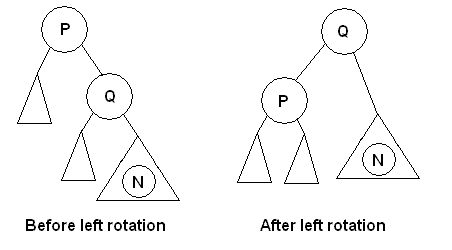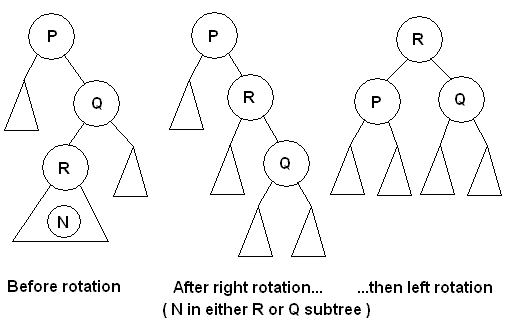C SC 205 Lecture 15: Balanced Binary Search Trees
major resources: Data Structures and the Java Collections Framework Second Edition,
William Collins, McGraw-Hill, 2005
Data Structures and Algorithms in Java Second Edition,
Adam Drozdek, Thomson Course Technology, 2005
[ previous
| schedule
| next ]
Monday November 5 (week 9)
The need for balance
- Balanced means that a tree with N elements has height that is O(log2N)
- In other words: For any node, the height its left subtrees is close to the
height of its right subtree
- You cannot regulate the sequence in which elements will be added to a Binary Search Tree
- If element values are added in a random sequence, the tree will be generally balanced
- If the first element added has a very low or high value, it will be out-of-balance at that level no matter what
- Worst case: element added in ascending or descending value
- In the worst case, adding, removing or locating an element requires linear time.
- In a balanced BST, adding, removing or locating an element requires logarithmic time.
Techniques for maintaining balance
- When can a balanced tree become unbalanced?
- When an element is added
- When an element is removed
- Goal: assure that a balanced tree remains balanced after the add/remove operation
- Different techniques define "balance" differently, but all result in O(log2n) add/remove/search
- Techniques for maintaining balanced binary search trees
- AVL Tree
- Red-Black Tree
- They have several things in common:
- Each entry (node) has additional information attached
- definitions have requirements that only a balanced tree can meet
- Their add() method differs from BinarySearchTree add in two ways
- include statements to maintain the additional node factoid
- after adding but before returning, call a method to rebalance the tree
- Their remove() method differs from BinarySearchTree remove in the same two ways
- Rebalancing is done through rotation (details below)
- Searching (e.g. getEntry()) is exactly the same as for BinarySearchTree
- Both are introduced in some detail below
- Techniques for maintaining balanced trees (not limited to binary)
- B-tree (similar to Red-Black, but a node may have many children; widely used in database systems)
- 2-3 Tree (every path is same length and all nodes have either 2 or 3 children)
- We will not consider these further
- Here is a simple technique for balancing an arbitrary BST -- but it does not
maintain the balance
- Create a temporary array AR with as many elements as are in the tree
- Create a temporary tree TT to hold the balanced tree
- Perform an in-order traversal of BST, placing each element into the first available AR index
- (Note the values in AR will be in ascending order)
- Add elements to TT from AR using this recursive method:
void balance(E AR[], int first, int last) {
if (first <= last) {
int middle = (first + last)/2;
TT.add(data[middle]);
balance(data, first, middle-1);
balance(data, middle+1, last);
}
}
- The above method, which I got from Data Structure and Algorithms in Java, Second Edition by Drozdek, will insert elements in "binary search" order, middle index first.
- Assign TT, the balanced tree, back to the original BST variable
- To reiterate: this will not maintain a balanced tree, but simply builds one.
AVL Trees
- Acronym formed from last initials of developers (Adel'son-Vel'skii and Landis,
1962)
- A binary search tree is either empty or for root R
- The height of R's left and right subtrees differ by at most 1
- R's left and right subtrees are both AVL trees
- Balanced is maintained upon adding/removing elements through rotation

- Left Rotation Rotate a given node X to the left -- X's
right child Y takes X's spot and X becomes Y's left child. X adopts Y's
existing left child as its new right child.
X.right = Y.left;
Y.left = X;
// Not shown: X's parent replaces X with Y as its left
or right child
- Right Rotation Rotate a given node Y to the right --
Y's left child X takes Y's spot and Y becomes X's right child. Y adopts
X's existing right child as its new left child.
X.left = Y.right;
Y.right = X;
// Not shown: X's parent replaces X with Y as its left
or right child
- Note: Description of right rotation is derived from description
of left rotation by exchanging all occurrences of "left" and "right", and
"X" and "Y"
- The purpose of left rotation is to reduce height of the right subtree.
- The purpose of right rotation is to reduce height of the left subtree.
- The desired effect doesn't always occur, in which case a double rotation
is needed
- Left rotation around X's left child followed by right rotation around
X
- Right rotation around X's right child followed by left rotation around
X
- The first will reduce height of left subtree.
- The second will reduce height of right subtree.
- Use balance factor to determine when to apply rotation and which
rotation to apply.
- balance factor is attached to each node
- = means both its subtrees have same height
- L means its left subtree has greater height (by 1)
- R means its right subtree has greater height (by 1)
- Rotations when Adding to a tree:
- Case 1: Suppose new node N is inserted into right subtree
of Q. Q is the right child of P and P is the first "unbalanced" ancestor
in the path from N to the root. P's balance factor shows its right subtree
is higher by 1. This means the new node can "tilt" P's subtree to the
right by 2. Re-balance by left rotating Q around P so Q becomes P's
parent.

- Case 2: Suppose new node N is inserted into Q's left subtree, which rooted at Q's left
child R. Q is the right child of P and P is the first "unbalanced" ancestor
in the path from N to the root. P's balance factor shows its right subtree
is higher by 1. This means the new node can "tilt" P's subtree to the
right by 2. Re-balance the tree through a
double rotation: first rotate right around Q so R becomes Q's parent (this
shifts weight toward the right) then rotate left around P so R becomes
P's parent.

- Case 3: symmetric to Case 1.
- Case 4: symmetric to Case 2.
- (source: Data Structures and Algorithms in Java Second Edition,
Adam Drozdek, Thomson Course Technology, 2005)
- Rotation may also be required when an element is removed from the tree.
Red-Black Trees
- Each node has an associated color: Red or Black (analogous to the AVL balance factor)
- A Red-Black tree is a binary search tree which is either empty or root R is Black and
- If an element is Red, none of its children can be Red
- All paths to nodes having less than two children must contain the same number of Black
elements. (note that a path includes the nodes at both ends)
- As a consequence of these rules:
- All Red elements will either have 2 children or none (leaf).
- If a Black element has 1 child, it must be a Red leaf.
- No path from a node to the root will contain two Red nodes in a row, but it can contain
two Black nodes in a row. So the path colors do not necessarily alternate.
- For a given node, one of its subtrees can have height at most twice the height of the other.
- This is the underlying data structure for the java.util.TreeSet and java.util.TreeMap classes
- See implementation details in source code of java.util.TreeMap
- Nodes are inserted or removed according to BST rules, then after the insertion/removal the tree may violate Red-Black protocal and need to be re-balanced"
- The details for this are found in private TreeMap method fixAfterInsertion() and fixAfterDeletion()
- Fixing a tree requires either a re-coloring of nodes, a rotation or both.
- Textbook author Collins says of the fixAfterInsertion method: "even if you study the code, it makes no sense!"
- For another humorous take on this process, see The Red-Black Tree Song
Useful balanced binary tree that is not a BST: Heap
- Data structure used for Priority Queues
- Priority queue means
- Each queue element has an associated priority (lower value is higher priority)
- The dequeue() method will return the queue element having the highest priority
- This is covered in Collins Chapter 13, with a homegrown class.
- We'll just cover the basics.
- A heap is a complete binary tree that is either empty or has root R such that
- R has a smaller value than either of its children
- R's subtrees are themselves heaps
- As a result of the above, the smallest value is always at the root
- Since a heap is required to be a complete binary tree, it is by definition balanced.
- Since it is complete, it can be easily represented by an array
- The enqueue() method adds an entry.
- There is only one to add it, to preserve tree completeness!
- But heap property has to be assured before returning
- Process for assuring this is called percolating up
- While node has greater value than its parent, swap value with parent then recurse up path to root.
- Worst case: have to percolate up to top, but logarithmic since tree is balanced.
- The dequeue() method removes an entry.
- Always removes the value at root, but we can't leave the gap!
- Place value from "last" node (rightmost, lowest level) into the root then delete
- Now the value at the root is large and we need to percolate down
- If root is larger than its children, swap root value with smaller of its children, then recurse on that child.
- Worst case: have to percolate down to the bottom, but logarithmic since tree is balanced.
- Result: enqueue() and dequeue() both are logarithmic time in the worst case.
[ C
SC 205 | Peter
Sanderson | Math Sciences server
| Math Sciences home page
| Otterbein ]
Last updated:
Peter Sanderson (PSanderson@otterbein.edu)


